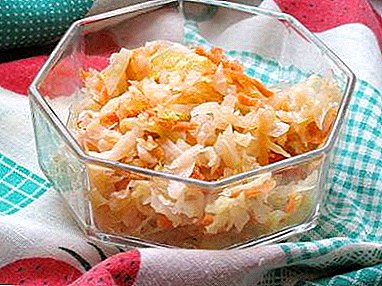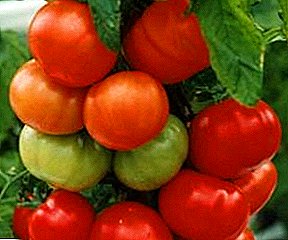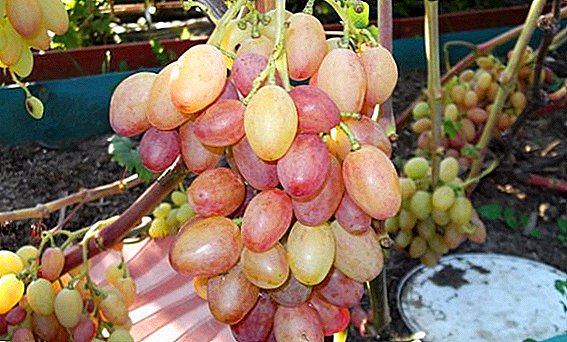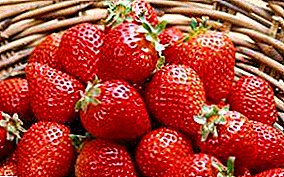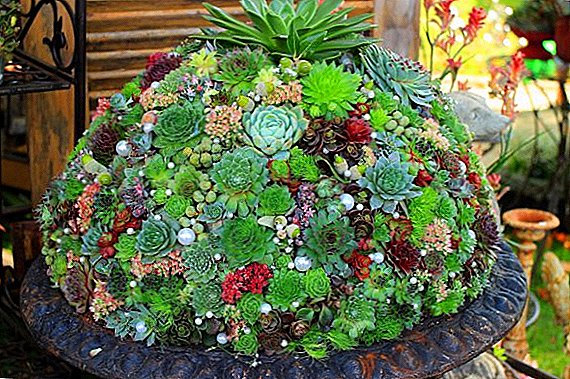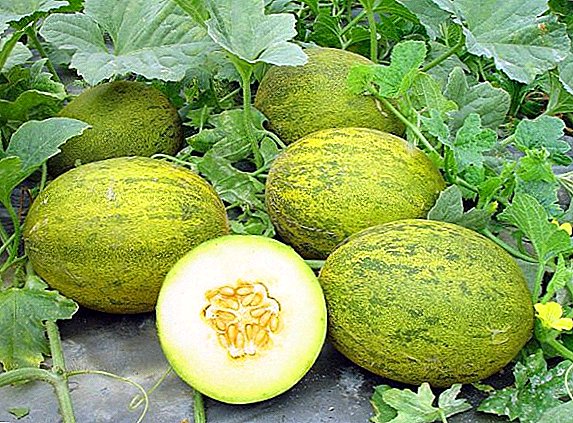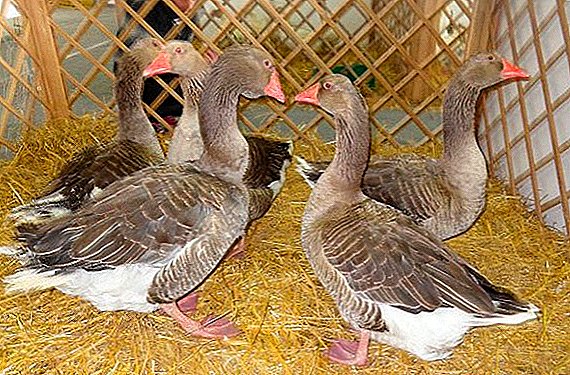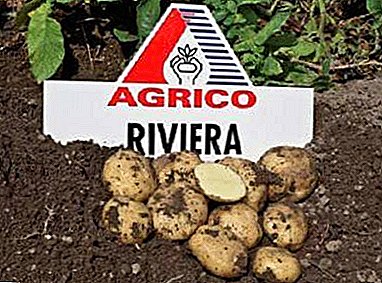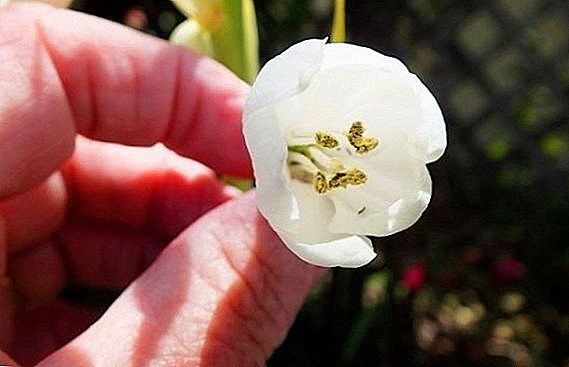 Whitish Galtonia (Galtonia candicans) - a graceful plant of the Lileins' family, which is easily remembered due to the numerous delicate hanging flowers-bells. Under natural conditions, there are four types of haltonia, but only one of them caught on our flower beds. Let's learn more about this plant and how to grow and propagate it.
Whitish Galtonia (Galtonia candicans) - a graceful plant of the Lileins' family, which is easily remembered due to the numerous delicate hanging flowers-bells. Under natural conditions, there are four types of haltonia, but only one of them caught on our flower beds. Let's learn more about this plant and how to grow and propagate it.
Botanical description
Whitish haltonia, also known as the Cape Hyacinth, is a bulbous perennial, growing in height to 0.5-1.5 meters and blooming in August and September. Its botanical characteristics are:
- bulb - size up to 7 cm, in the form of a cone with a concave base, covered with a large number of dry scales;
- leaves - grooved, gray-green, naked, juicy, basal, belt-shaped, up to 90 cm long and up to 8 cm wide;
- flowers - snow-white, drooping, tubular-funnel-shaped, up to 6 cm long and up to 3 cm in diameter, inflorescences in the form of a brush of 20 flowers or more;
- fetus - an elongated box of three faces;
- the seeds - wrinkled, flat, triangular and black.

Did you know? The world's largest flower - Rafflesia Arnoldi - grows in the Malaysian jungle. Its size reaches one meter, and weight - up to seven kilograms. This incredible flower is a predator, it emits a scent that resembles rotten meat, which attracts various insects.
Spread
South Africa is the birthplace of whitish galtonia. It received its name by the name of a researcher of African vegetation Englishman Francis Galton. The second name of the plant is associated with its natural distribution area - the Cape Mountains in southern Africa.
In its natural environment, whitish haltonia grows on sunny mountain slopes covered with bushes and grasses. Today, it is widely used in Europe, where it began to breed with the 70s of the XIX century.
Application in the garden and landscape design
Due to its unpretentiousness and spectacular appearance, galtonia is actively represented in landscape design. It looks great in different types of planting flowers - among the ornamental deciduous plants and perennials blooming in autumn. It is used as a grassy border in high flower beds or as central plants in adjacent flower beds.
Learn how to create rabatka, flower bed, alpine slide, mixborder.

Haltonia is good for cutting and is sometimes grown in pots. It is effective when planted in limited groups in the company of phlox, gelenium, aquilegia, asters, gladioli, cannes and peonies.
Also, the plant can be planted with spring bulbous crops that do not require digging for the winter. The Cape hyacinth will cover its leaves with faded tulips and daffodils and will remarkably retain its decorative throughout the summer.
Growing at home
Despite the exotic African origin, whitish galtonia feels pretty good in mid-latitudes and does not require complex care. Like other garden flowers, it needs timely watering, dressing and periodic loosening of the soil.
Important! Regularly inspect the stored planting material, separate the damaged specimens and treat the damaged manganese with potassium permanganate. If the bulb does not bloom in the first year after planting, it is possible that it has weakened and with proper care will give color in the next year.

Choosing a landing site
Whitish haltonia prefers to grow in the sun or in partial shade, the southern part of the garden is well suited for it, especially if it is located on a slope. In open areas, high arrows need to be tied up to avoid lodging. At the end of flowering, flower stalks are best removed, so as not to deprive the bulb.
The plant is rather cold-resistant, it is accustomed to natural conditions - hot summer and cold winter. However, in the middle lane it is better to hide. For this you can use peat or sawdust with a layer up to 20 cm and cover it with spruce leaves or dry leaves.
Find out what care is required: snowdrops, hyacinths, lilies, montbretias, candiks, gladioli, chionodoxes, marshmallows, pushkins, levkokorin, crinums, sparaxys, autumn crocuses, hazel grouses, tritles, tigridia, ixia, crocuses.
In colder places, the bulbs are dug out at the end of October and stored at a temperature of 6-12 degrees Celsius. Dig the plant very carefully so as not to damage the root system. You shouldn’t be in too much of a hurry, the whitish galtonia will transfer small frosts quite well, so it’s better to give the onion time enough stock up with enough nutrients for a long winter. If there are quite a lot of bulbs, you can experiment and dig up some of them, and leave some to overwinter in the ground.
Dug out plants with leaves for 7 days are left in a well-ventilated area for drying. After which the leaves are cut 1-2 cm from the bulbous neck, and the roots are left intact. Another 1-1.5 weeks they are dried at room temperature, and then stored in sand or peat in a dry room at a temperature of 10-15 degrees Celsius.  Some gardeners store the bulbs in the vegetable compartment of the refrigerator, but then you need to ensure that they are not damp.
Some gardeners store the bulbs in the vegetable compartment of the refrigerator, but then you need to ensure that they are not damp.
Soil and fertilizer
Whitish halton should be planted in slightly acidic soil with the addition of humus. She prefers drained land with good oxygen access to the root system. Therefore, the land should be cultivated deeply, and before planting, make it well weathered peat.
Learn how to determine the acidity of the soil, how to deoxidize, how to use peat and other organic fertilizers.During the growing season, plants should be fed 1-2 times with a complex of mineral fertilizers for bulbous crops.
Watering and moisture
Whitish haltonia requires abundant watering during the growing season, the rest of the time it is sufficient to water it moderately. Be sure to take care to prevent stagnant water and rotting of the roots.  The next day after watering it is necessary to loosen the soil well, at the same time weeding all the weeds that appeared.
The next day after watering it is necessary to loosen the soil well, at the same time weeding all the weeds that appeared.
Did you know? A tree of the legume Tseratoniya always gives absolutely identical seeds weighing 0.2 g. In ancient times, they were used by jewelers as weights, and now this measure of weight is called "carat".
Breeding
Whitish haltonia reproduces in two ways:
- bulbs;
- seeds.
Sowing seeds in open ground
Sowing in open soil is carried out with fresh seeds. They are sown at the end of April, and after the emergence of shoots in May, thinned or seated at a distance of 10-15 cm from each other. When planting seeds, the plant begins to bloom in the 2-3rd year.
Seedlings rather unpretentious, but slowly developing and require careful watering. As a rule, this breeding method is not used very often. 
The division of the bush
In the spring before planting, bulbous nests are divided into 2-3 parts or disassembled into independent onion bulbs and planted. It is important to do this carefully so as not to damage the roots. Should be planted from late March to May, with the later landing will be, the later the color will appear.
When grown in open soil, the bulbs are planted to a depth of 15-18 cm with a step between them - 30 cm. For better drainage, coarse sand is poured to the bottom of the pit, and peat or humus is also added. Planted onions need to be watered well, but do not allow stagnant water. Shoots appear 2-4 weeks after planting.
Important! Haltonia grows well in one area of 4-5 years, forming dense thickets. However, she does not like to have her often transplanted. Sometimes, especially in the southern regions, the plant multiplies by self-sowing.
Seed collection
Seeds should be collected in the fall after flowering plants simultaneously with the removal of peduncles. Seed material should be taken only from healthy and strong plants, without signs of any diseases.  The collected seeds must be dried. To do this, lay them out in one layer on the surface with dense wax paper and put in a dark warm place with good ventilation. Properly dried seeds will remain fine until spring. However, they should "breathe" well, so it is better to store them not in plastic or polyethylene, but in paper envelopes.
The collected seeds must be dried. To do this, lay them out in one layer on the surface with dense wax paper and put in a dark warm place with good ventilation. Properly dried seeds will remain fine until spring. However, they should "breathe" well, so it is better to store them not in plastic or polyethylene, but in paper envelopes.
Pests, diseases and prevention
The flower is quite resistant against diseases and pests. A good soil drainage provides reliable protection against fungal infections of the roots.
However, in wet weather, the Cape Hyacinth may begin to attack snails and slugs. To prevent this, the site should be treated with wood ash for the purposes of prophylaxis. And appearing gastropods to collect hands.
Whitish haltonia refers to those plants that do not cause much trouble and become a wonderful decoration of the flower garden. And in the beginning of autumn, when the main plants have already bloomed and are preparing for rest, the bright multicolor of whitish galtonia will return the feeling of spring and give a good mood.
Video: how to grow halton


